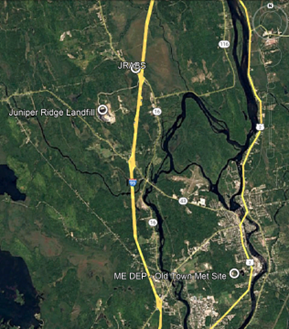Home → Air Quality → Monitoring and Reporting → Juniper Ridge Monitoring
Juniper Ridge Air Toxics Monitoring Project
Data Downloads
Data files are expected to be updated monthly to include all data up to the previous month. For comparative purposes, the HAPs data from our Bangor monitoring site is included. VOCs indicative of landfill gas include aromatic and halogenated compounds (included within the chlorinated solvent grouping in the spreadsheet). Currently, average concentrations of VOCs and particulate matter detected at the two sites are similar. All data is considered preliminary and is subject to change.
- DEP VOC HAPs (xlsm)
- DEP PM2.5 (xlsx)
- Hydrogen Sulfide: (coming soon)
The Juniper Ridge Landfill in Old Town Maine, operated by Casella Waste Systems has been the source of air quality complaints for many years. As part of normal landfill operations, organic matter in the landfills will decompose, creating ‘landfill gas’ that escapes the landfill and travels downwind. This landfill gas may contain many different gases. Typically, over 90% of this gas being the odorless methane and carbon dioxide compounds. Landfill gas also contains hydrogen sulfide (H2S), which is a colorless gas, with even just trace amounts having the characteristic foul odor of rotten eggs. In May of 2023, a fire at the Juniper Ridge Landfill sparked additional concerns about the landfill by the public. Many citizens were concerned about the quality of their air and requested that the DEP initiate its own air quality sampling in the area, independent of the H2S monitoring already being conducted by Casella Waste Systems.
The State developed Ambient Air Guidelines (AAGs) for hydrogen sulfide and other Hazardous Air Pollutants1 (HAPs), which are set at a concentration for each chemical below which there is a minimal health risk. The AAG for H2S is defined by a long-term chronic, annual average limit of 1 ppb, and a short-term acute, 1/2 hour average limit of 30 ppb2. The objective of the Maine DEP is to obtain air quality data in the vicinity of Juniper Ridge Landfill for comparison against the AAGs for a health risk assessment.
The levels of hydrogen sulfide in air are typically low. The amount of hydrogen sulfide naturally found in the air has been estimated as 0.11 - 0.33 ppb (0.15 - 0.46 ug/m3 ). Lower levels (0.02 - 0.07 ppb; 0.03 - 0.1 ug/m3 ) have been observed in some remote areas2.
When the project was initialized, the Department did not have the ability to measure H2S. The Department had borrowed some H2S sensors from the US EPA prior to starting this project, but it was determined that the sensitivity of these sensors could not meet the need to provide meaningful data for comparison to the Maine AAGs. The Department pursued other options to obtain an instrument capable of trace-level measurements for H2S. Despite being unable to do monitoring for H2S, the Department initialized HAPs monitoring for many Volatile Organic Compounds (VOCs).
Status of Air Monitoring

Click to view larger
Phase 1 – Initial deployment (Current Stage)
In November of 2023, the Department installed a HAPs sampler to begin collection of VOCs samples. These samples are collected over a 24-hour duration from midnight to midnight and run on a 1 in 6-day frequency. The collected samples are sent to the DEP Air Analytical Lab for analysis. The Department also deployed a Purple Air Particulate Matter (PM) sensor. Both the Purple Air and HAPs sampler are installed at a residence near the landfill entrance.
The Department also maintains a meteorology site in Old Town, Maine. This site collects wind speed and direction data that can be used in determining when our monitoring equipment is downwind of the landfill.
Phase 2 – Addition of H2S Monitoring
The Maine Department of Environmental Protection purchased an instrument for the purposes of monitoring H2S. This new Instrument (AROMA-TOX by Entanglement Technologies) is capable of continuously measuring H2S down to 1-ppbv. This would provide the department with data that can be compared to the Maine AAG for health risk assessment. The Department acquired an AROMA-TOX instrument in January 2024; however, this type of instrumentation is new to the Department and staff training and instrument testing will have to be conducted prior to field deployment to ensure that all data produced by this effort is of the highest possible quality. The AROMA-TOX will be deployed for at least 1-year to produce an annual average. After the 1-year sampling period, the AROMA-TOX may be redeployed to other areas of the State with H2S concerns.
Potential for future expansion
The Department may add an additional HAPs sampler and Purple Air PM sensor at a second location near the vicinity of the Juniper Ridge Landfill. The department currently has other limitations preventing this and the timeline to overcome these limitations is uncertain.
Contacts and Resources
For more information about the air quality monitoring, contact David Lemery.
To file an air quality complaint regarding Juniper Ridge Landfill, contact New England Waste Systems of ME at (207) 394-4376
More information regarding the Juniper Ridge Landfill license
Sources
- https://www.maine.gov/dep/air/monitoring/docs/ME_DEP_AAG_LIST_2024_FINAL_w_notes.pdf
- https://www.maine.gov/dep/waste/publications/documents/ambientairguidelines.pdf